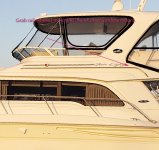I tried mounting the Hamstick on the side of my fly-bridge which has a grab-rail. I used a trucker window mount to grab onto the rail (rail is not bonded/grounded to anything). I then took 17' of wire, had one end tied to the antenna mount, the other sloping down the side of the boat into salt water. I could not get even a 5:1 on 20 or 40.
So, I have this large hardtop on top of the fly-bridge. My radar, Nav. Light & VSAT dome... all in the rear part of the hardtop. I have a lot of room in the middle and front of the top to possibly put down a sheet of galvanized sheet-metal to use as a ground and screw the sheet into the top.
I do not want to purchase the extra-large 23' Shakespeare Marine HF antenna and auto-tuner as it is an expensive solution. When you're a boat owner, you are always looking out for some way to save money on a new purchase. Also, I do not want to make a wire antenna, so that is off the table for me. I already own most everything I need with the exception of the metal plate.
I welcome any suggestions.
Picture of "Lattitude Adjustment 3"


So, I have this large hardtop on top of the fly-bridge. My radar, Nav. Light & VSAT dome... all in the rear part of the hardtop. I have a lot of room in the middle and front of the top to possibly put down a sheet of galvanized sheet-metal to use as a ground and screw the sheet into the top.
I do not want to purchase the extra-large 23' Shakespeare Marine HF antenna and auto-tuner as it is an expensive solution. When you're a boat owner, you are always looking out for some way to save money on a new purchase. Also, I do not want to make a wire antenna, so that is off the table for me. I already own most everything I need with the exception of the metal plate.
I welcome any suggestions.
Picture of "Lattitude Adjustment 3"


Last edited:


